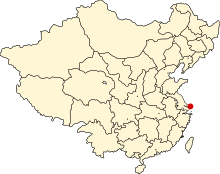| Some of this article's listed sources may not be reliable. Please help improve this article by looking for better, more reliable sources. Unreliable citations may be challenged and removed. (August 2023) (Learn how and when to remove this message) |
| Provisional Municipal Government of the Special City of Shanghai上海特别市临时市政府 | |
|---|---|
 Location of Shanghai within the Republic of China | |
| Capital | Shanghai |
| Historical era | Northern Expedition |
| • Established | 22 March 1927 |
| • Disestablished | 1 April 1927 |
The Provisional Municipal Government of the Special City of Shanghai (Chinese: 上海特别市临时市政府; pinyin: Shànghǎi Tèbiéshì Línshí Shìzhèngfǔ), also known as the Shanghai Civil Government (Chinese: 上海市民政府; pinyin: Shànghǎishì Mínlínshí) or Shanghai Commune, was a provisional administration that briefly governed the city of Shanghai during the Northern Expedition. Established by people's committees with the assistance of Chen Duxiu, Zhou Enlai, and the Chinese Communist Party (CCP), the commune briefly administered the city of Shanghai before its forceful dissolution by order of Chiang Kai-shek. The dissolution of the Shanghai Commune would lead to the 1927 Shanghai massacre, and the onset of the Chinese Civil War.
Background
As Shanghai held a large industrial base, the CCP, who were influenced by the events of the October Revolution, viewed Shanghai as a natural base for a worker's uprising in China. By 1927, popular opposition to the control of local warlords, combined with the growing military successes of the First United Front encouraged local organs of the CCP to overthrow the local administration, leading to two separate armed uprisings between January and early March 1927.
Formation
During a general strike on March 22, 1927, Chen Duxiu and Zhou Enlai would lead a group of 5,000 armed workers in the city's third armed uprising. After seizing the city by 6pm, they, along with Soviets organized by strikers, established the Shanghai Provisional Municipal Government along the lines of the Paris Commune. During the meeting, 19 members were elected to the municipal government, with 9 representatives from the CCP, and 9 from the various factions of the Kuomintang.
Dissolution
After receiving word of its formation, Chiang Kai-shek demanded that the Shanghai Commune be dissolved, and appointed Right KMT officials as heads of a future provincial government. Chen Duxiu would then hold a meeting with members of the CCP, including Zhou Enlai, preparing for conflict with Chiang Kai-shek. However, the municipal government would have to garner support in resistance against Chiang from both the Kuomintang's Left Faction, and the Communist International. As a result, the Comintern's actions in China would be criticized both by some within the Soviet Union, such as Leon Trotsky, and by retrospective scholars. Troops loyal to Chiang would ultimately enter the city on April 12, and dissolve the commune.
See also
- The Shanghai People's Commune established during the Cultural Revolution
References
- ^ Yuqi, Chen (2007). "谁扼杀了上海的巴黎公社" [Who killed Shanghai's Paris Commune?]. 论陈独秀 [On Chen Duxiu] (in Chinese). China: Association for the Promotion of Marxist Studies.
- 中共中央党史研究室, (Party History Research Office of the Central Committee of the Chinese Communist Party) (April 2, 2013). "上海工人三次武装起义" [The Three Armed Uprisings of Shanghai Workers]. Research Institute on Party History and Literature of the Communist Party of China's Central Committee (in Chinese). Retrieved September 1, 2023.
- 中国共产党新闻网, (Chinese Communist Party News Network) (May 8, 2020). "上海工人举行第三次武装起义" [Staging of the Third Armed Uprising of Shanghai Workers]. All-China Federation of Trade Unions.
- Shu, Jin (2008). "上海工人三次武装起义中的巴黎公社元素" [Elements of the Paris Commune in the Three Armed Uprisings of Shanghai Workers]. Party Literature (in Chinese) (5) – via China University of Geosciences.
- Li, Tiangang. "上海市民自治運動的終結" [The End of the Shanghai Citizen's Autonomy Movement] (PDF). Chinese University of Hong Kong (in Chinese). Archived from the original (PDF) on February 18, 2015. Retrieved September 1, 2023.
- Trotsky, Leon (1967). "The Chinese Revolution and the Theses of Comrade Stalin". Problems of the Chinese Revolution (1927-1931). University of Michigan Press. ISBN 978-0472061310.
- Saich, Tony (September 14, 2015). "The Chinese Communist Party during the Era of the Comintern (1919-1945)" (PDF) – via Institute of World Politics.
| Chinese Civil War | |||||||||||||||||||||||||||||||||||||||||||||||||||||||
|---|---|---|---|---|---|---|---|---|---|---|---|---|---|---|---|---|---|---|---|---|---|---|---|---|---|---|---|---|---|---|---|---|---|---|---|---|---|---|---|---|---|---|---|---|---|---|---|---|---|---|---|---|---|---|---|
| |||||||||||||||||||||||||||||||||||||||||||||||||||||||
| |||||||||||||||||||||||||||||||||||||||||||||||||||||||
This article related to the history of China is a stub. You can help Misplaced Pages by expanding it. |